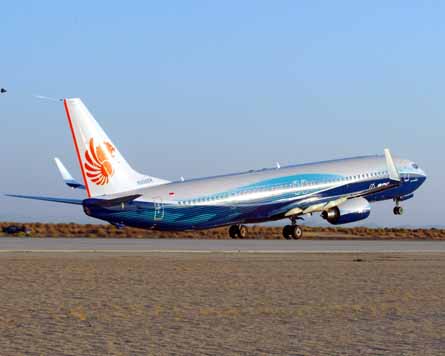Development aircraft undergo aggressive schedule as Boeing overcomes test delays
Certification of the Boeing 737-900ER is still on schedule to meet its original April delivery target to launch customer Lion Air despite extended testing periods caused by faulty sensors, and additional evaluation for revised stall characteristics and the autoland system.
"We're around 97% through," says 737 chief test pilot Ray Craig, who adds that more than 325 flight hours have been amassed by the two test aircraft, YH001 and YH002. From the first flight on 1 September of YH001, which has just over 300h of test time, the effort has clocked up around 60h a month, "which is fairly aggressive", says Craig.
The high test rate is attributed to the earlier dedicated test work on an -800 of the short-field performance improvement package, which is one of the major configuration changes. Other new features on the -900ER include a flat aft pressure bulkhead, additional exit doors, and modifications to the elevator feel system and the autoland system.
|
|---|
Boeing says recent take-off testing of the 737-900ER at Edwards AFB went "very well" |
"Overall, the aircraft has performed exceptionally and the recent take-off testing at Edwards AFB has gone very well. We've validated all of our projections with regards to the short-field performance tests, and we're happy with our projections for shorter take-off," he adds.
The testing did, however, uncover the need for "small changes" to the revised elevator feel system, which was introduced to enable crew to easily handle the increased 84,900kg (187,000lb) gross take-off weight of the -900ER.
"We wanted it to be similar to the other models and had to change part of the feel system to do that. We looked at the original design and, as we'd bumped up the take-off speeds, we thought we'd have higher forces for take-off. Our goal is to have rotation forces like an -800/900."
The testing also focused on a "more robust" autoland system developed to overcome a "slight limitation" experienced by the -900, says Craig. The issue cropped up because of the difficulties encountered by the original control laws in compensating for the increased approach speed used at higher-altitude airports.
Windshear disrupts YH001 |
|---|
Boeing has transferred remaining test work to YH002 following an incident during abused landing tests with YH001 at Edwards AFB around 9 February. Boeing says the aircraft "experienced a small windshear event", and that it is "carefully reviewing the data gathered during the flight to ensure that all factors have been considered for the performance data used in the subject condition". External doublers were added to the skin to enable YH001 to ferry back to Seattle for maintenance. Although the shift to YH002 will delay its refurbishment for delivery to Lion Air, Boeing adds that "there is no reason to expect a delay at the moment". |
"It's a combination of slower approach speeds and newer software," says Craig, who adds that the new system "has rolled in control laws from the 767/777" and is being considered for potential retrofit to the -800. "No decisions on that have been made yet," he says.
Delays were caused by the unexpected need to replace strain gauges in the horizontal stabiliser around year-end, and by the weather, which refused to co-operate for several days while the test team hunted for suitable crosswinds for the autoland tests.
"We also did some testing with the new leading-edge slat configuration and added Boeing stall testing to that, which used up one or two weeks," adds Craig.
Source: Flight International
























